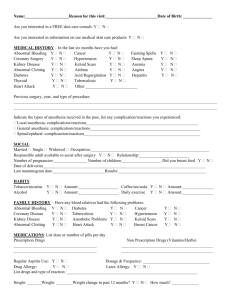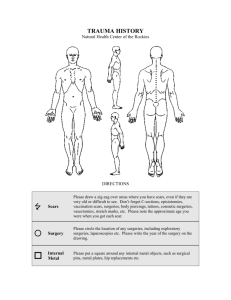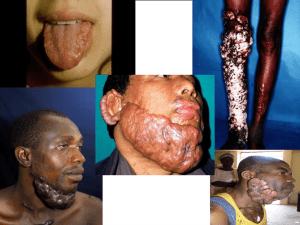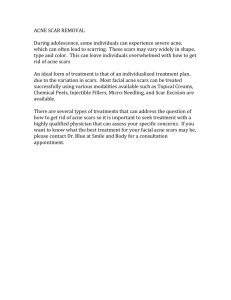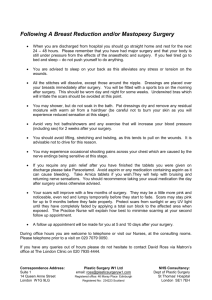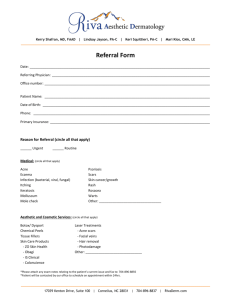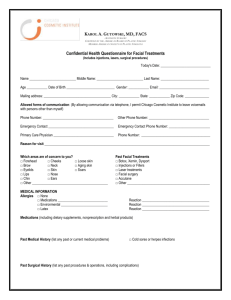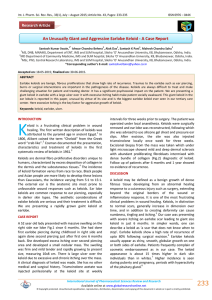plastic surgery and environ
advertisement
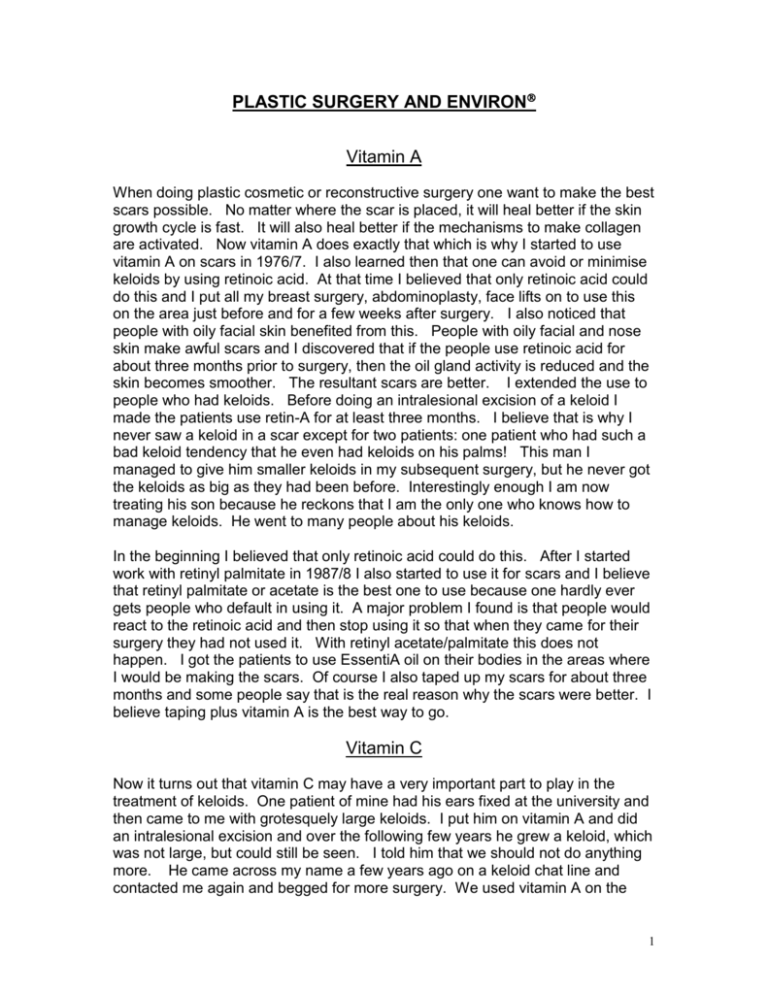
PLASTIC SURGERY AND ENVIRON Vitamin A When doing plastic cosmetic or reconstructive surgery one want to make the best scars possible. No matter where the scar is placed, it will heal better if the skin growth cycle is fast. It will also heal better if the mechanisms to make collagen are activated. Now vitamin A does exactly that which is why I started to use vitamin A on scars in 1976/7. I also learned then that one can avoid or minimise keloids by using retinoic acid. At that time I believed that only retinoic acid could do this and I put all my breast surgery, abdominoplasty, face lifts on to use this on the area just before and for a few weeks after surgery. I also noticed that people with oily facial skin benefited from this. People with oily facial and nose skin make awful scars and I discovered that if the people use retinoic acid for about three months prior to surgery, then the oil gland activity is reduced and the skin becomes smoother. The resultant scars are better. I extended the use to people who had keloids. Before doing an intralesional excision of a keloid I made the patients use retin-A for at least three months. I believe that is why I never saw a keloid in a scar except for two patients: one patient who had such a bad keloid tendency that he even had keloids on his palms! This man I managed to give him smaller keloids in my subsequent surgery, but he never got the keloids as big as they had been before. Interestingly enough I am now treating his son because he reckons that I am the only one who knows how to manage keloids. He went to many people about his keloids. In the beginning I believed that only retinoic acid could do this. After I started work with retinyl palmitate in 1987/8 I also started to use it for scars and I believe that retinyl palmitate or acetate is the best one to use because one hardly ever gets people who default in using it. A major problem I found is that people would react to the retinoic acid and then stop using it so that when they came for their surgery they had not used it. With retinyl acetate/palmitate this does not happen. I got the patients to use EssentiA oil on their bodies in the areas where I would be making the scars. Of course I also taped up my scars for about three months and some people say that is the real reason why the scars were better. I believe taping plus vitamin A is the best way to go. Vitamin C Now it turns out that vitamin C may have a very important part to play in the treatment of keloids. One patient of mine had his ears fixed at the university and then came to me with grotesquely large keloids. I put him on vitamin A and did an intralesional excision and over the following few years he grew a keloid, which was not large, but could still be seen. I told him that we should not do anything more. He came across my name a few years ago on a keloid chat line and contacted me again and begged for more surgery. We used vitamin A on the 1 skin and also Crystal masque applied daily to the area of the keloid. He did this for three months post-operatively and never grew a keloid. To date he has not developed a keloid and he is about 25 years old so has not outgrown the age for keloids. Another patient who had breast surgery developed a hypertrophic scar on her breast even though she generally makes invisible scars. We had not prepared her skin because I knew she makes such good scars. The hypertrophic scars responded to crystal masque applied under occlusion of plastic. It caused something like a peel to the area but the scars flattened and the red disappeared. I have not used this on many cases. As a standard post-operative care for face lifts I believe that the C-Quence 3 is probably the finest that we can offer. Not only will the scars mature well, but the facial skin will get a younger appearance. Peeling: The Environ® peels have special advantage because they are mild and yet can be converted into heavier peels by either layering them thicker, or by leaving them on for a longer time. I found that if one does a mild peel to a scar within a day or two of surgery, then the scar settles down faster and looks more mature. I once was visited by a famous Japanese plastic surgeon, Dr. Yukio Shirakabe, and he was with me when I was seeing a patient who had had a face-lift. I showed him the scars and then he asked the patient when she had had her surgery. He was very surprised to hear that it was about 10 days before. The scars looked like six months scars he said. I apply the TCA cream 5% to the scar for about 10 minutes and do this on the second day after surgery, and every day or two afterwards when they come in for their normal follow-up. I now also use the 5% TCA Pamgel and it works just as well. TCA (and I imagine AHAs clean up infections because they kill the bacteria. Bacteria have no resistance to acid and so one does not have to worry about what type of bacteria one is dealing with. I have been consulted on two occasions by dermatologists to help them with awful infections of the face. They both had large septic areas in the dangerous triangle of the face near the nose, and had been on numerous antibiotics and were not responding. The abscesses were draining. I applied the TCA cream 5% and left it on until the edges of the abscess frosted. Both of these guys told me that about 20 minutes later the pain in their face subsided. The one guy was so bad that I had asked him to come back in the evening for another treatment, and by then the oedema was showing signs of dissipating. I treated the abscess again and then had him in for daily treatments. Within about four days his dangerous signs had disappeared and the abscess stopped draining, and he healed despite not being on any additional antibiotic. In fact he stopped using the antibiotic after about 2 two days. He healed without a major scar and I see him often because he owns a restaurant that I go to periodically. I have also used peeling for horrible fungal toe or fingernail infections. Takes time - about two months but then so do the very expensive antifungals. I am considering writing a paper about this - but ... time!!!! Of course peeling is great for acne but only if the person is using vitamin A at the same time. Then one can push the vitamin A dose higher and control the acne with peeling. Iontophoresis and sonophoresis: I believe we have a very powerful tool here for treating scars, and also for making skin look younger and getting the best effects from cosmetic plastic surgery. For everyone doing a face-lift I recommend a series of about 24 iontophoresis treatments done either twice a week or once a week, or at the worst on alternative weeks. The crystal masque and the vitamin A gel are the usual agents used. However, Serum C-Quel should not be forgotten in those people with less sun-damage. Acne scars can be treated better by iontophoresis of vitamin A gel. This we have shown to give better results than resorting to dermabrasion. If dermabrasion has recently been done then a course of these treatments should give healthier skin and a better result: a major point that should be kept in mind. We have done intensive iontophoresis for dense post-burn scars and we have been able to flatten the scars and make them less ugly. Eventually this will also be a paper. In summary, every plastic surgery patient should use the Original or Ionzyme series. Where we want more intensive effects then we use iontophoresis and sonophoresis. If the skin is infected then mild peeling has an important role to play e.g. acne. It may also help to get skin looking better though once one has treated the surface roughness, then the iontophoresis will give better results. The combination of mild peeling on a fresh scar and vitamin A and C I believe gives the best possible scars. Hope that this is of value. Greetings Des 3
